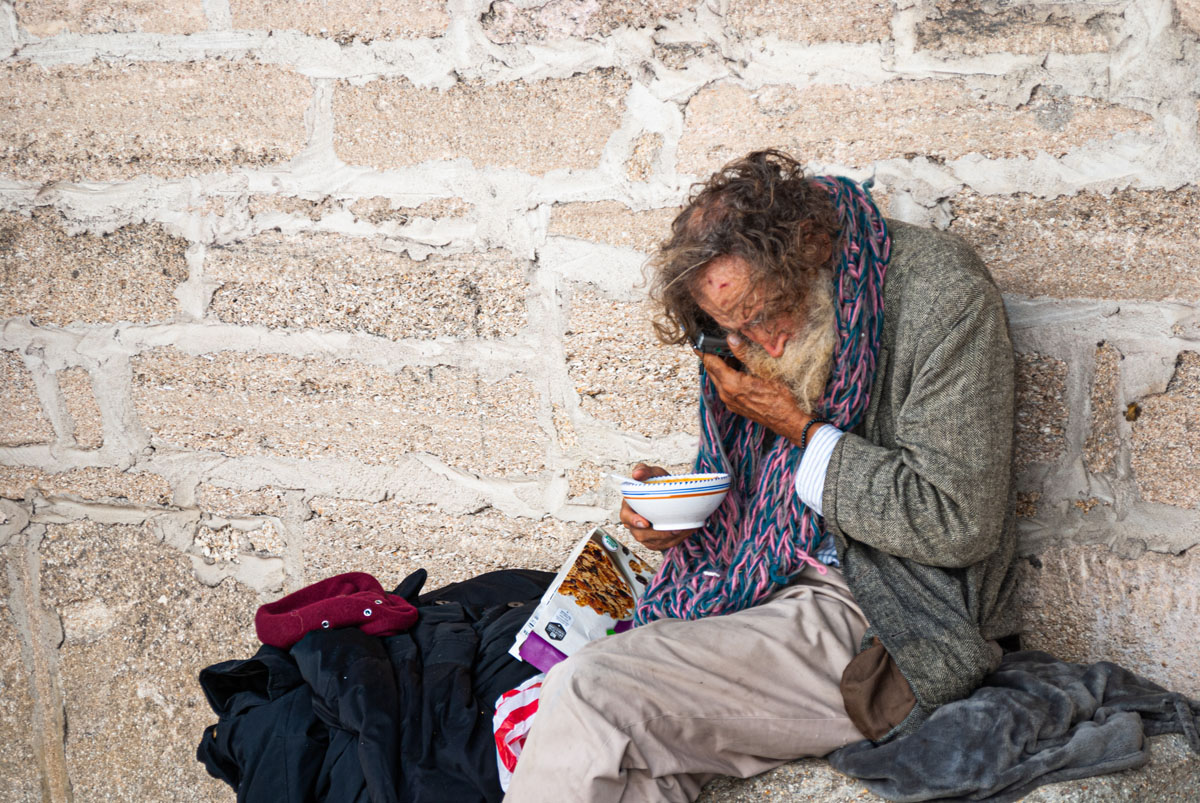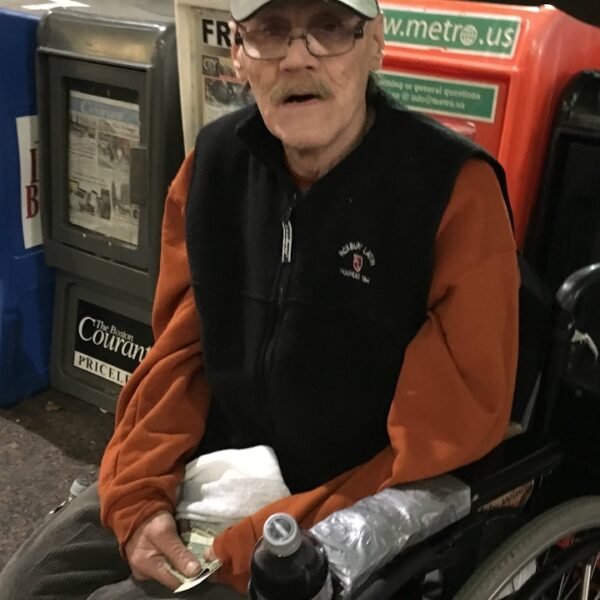Smartphones are the Smarter Way to Fight Homelessness, Part 2: Leveraging
You are scrolling through your phone, looking at pictures, posing for selfies, posting a snap, or sending this article as a tweet. All the while, during this brief interaction, bigtime corporations are tracking your every move, turning screenshots into targeted ads, and delving through your purchase preferences and history to pull up the perfect advertisement that’s right in your zip code (which they pulled out of your Google Maps location) so it hits very close to home.
While at first, the 24-7 surveillance feels intrusive, the luxury of having just about anything you could imagine at your fingertips is far too attractive to pass up. And this is exactly how the smartphone was designed to operate.
When Steve Jobs first envisioned the iPhone, he wasn’t picturing a phone at all.
He wanted something so essential, a device so important that people couldn’t bring themselves to live without it, even for short periods of time. Today, 96% of US citizens are proud owners of a smartphone and the average American spends less than two hours a day away from theirs.
For-profit brands have been leveraging mobile data for years. In fact, the entire mobile commerce industry is booming. Just last year, Mcommerce sales broke records on both Black Friday (US$ 2.9B) and Cyber Monday (US$ 3.1B). And the future is projected to be even brighter as mobile forges through. By 2021, mobile is expected to be the leading online salesforce, driving 54% (or $659 billion worth of sales) into the industry.
Even brick and mortar stores are getting in on the action by way of proximity marketing (which is really just a fancy term for getting alerts when someone who has downloaded their store’s app is in the proximity).
When it comes to phones, it’s not just the salespeople who want your number these days. It’s doctors and lawyers, authors, architects, and app developers, too. It’s every for-profit sector with a story or a product to push.
But what about us non-profit organizations? Aren’t we always screaming about savings? Isn’t it about time that we smarten up and pay attention to these ever-evolving mobile trends?
Steve Jobs wanted to create a product that would change the world. And he did. But that’s not the best part. The best part is that with it, others can change the world too- and that includes you.
In part 1 of this Smartphone series, I talked about how statistics now prove that homeless people with smartphones are more likely to acquire housing than those who don’t have smartphones. Today, I’m going to talk about how non-profits can cut costs, save lives, and get more people off the streets and into housing by doing what for-profits have been doing for years – leveraging mobile technology. I’ll share how you can get involved as well.
Question: Why Are We Still Using Static Solutions to Remedy Transient Situations Like Homelessness?
At its core, homelessness is drifting, wandering, being moved from one far-off corner to the next, from a shelter to a prison, a prison to a hospital, a hospital to an encampment, etc. It is a never-ending circle that’s impossible to pinpoint. But mobile tech makes what was once impossible, manageable.
Lately, the internet in corroboration with cellular data has become a lifeline for people of all walks of life. Any movement for digital inclusion should most certainly include people experiencing homelessness. Homelessness is a kind of wilderness all its own. And a smartphone is a smart thing to bring if you think you might get lost in a forest.
At its surface, a smartphone is a flashlight and a camera. It’s a GPS and a bus schedule. It’s an adviser, a guide, a direct line to the warm voice of a friend. Something like that just might get you through a cold night in a dark alley or an old abandoned building.
It is not as if homeless people in the past had nothing. Before the mobile boom, every sidewalk in every city had a payphone on every corner. Just imagine the kind of isolation people enduring the horrors of homelessness must have felt when seemingly overnight, those payphones up and disappeared.
Mark Horvath, the founder of Invisible People and a leader in digital inclusion who facilitates an online support group for homeless and formerly homeless people, has been conducting what he calls virtual case management for almost a decade.
Through mobile tech and social media, he’s managed to connect case managers and social workers to vulnerable people who were in need of their services. If something like this happened on a larger scale, the non-profit sector could cut costs, save lives, and maybe even obliterate homelessness altogether.
Not overnight, but in due time, social services would become portable. Point in time counts would become more accurate. Support groups could be run for free on Facebook rather than being conducted in pricey office buildings that are difficult for someone with no money to get to in the first place.
Just think of all the purposes a cellular connection with Wi-Fi would serve the homeless community. Here are just a few that come to mind:
- Means of Connection. Smartphones could serve to keep people who lack stable housing in connection with service workers, friends, family members, employers and more. They could make use of video chat to do interviews, talk to outreach teams, get housing advice, etc.
- Virtual Escape. The rest of us get the opportunity to escape from our problems while browsing online. Wouldn’t this same sort of virtual escape help boost the esteem of our unhoused neighbors?
- Means of Employment. For someone who lacks a stable physical address, virtual employment, which is currently on the rise like never before, could help them out of financial distress.
- Filling out Forms. From applying for social services to filling out job applications or sending in identification cards over email, communication would become that much more seamless in a virtual world.
- Saving Time. The entire non-profit sector and the people it serves could save a great deal of time and energy by telecommunicating and therefore avoiding in-person meetings
- Protection. From the power of video recording to the simple ability to make a call in times of distress, a smartphone could easily save a homeless person’s life.
Telehealth: How Virtual Visits Could Save Lives and Tax Dollars
Telemedicine has been growing for many years – except in the homeless sector. Now, because of COVID-19, it’s exploding – except in the homeless sector, where it’s still being ignored.
As the world struggles under the weight of the novel Coronavirus, the homeless community remains uncounted and underserved. This is particularly true in the growing field known as telehealth. With teledoctors waiting in the wings, patients save time and travel expenses while doctors avoid burnout and gain more revenue because no-shows become a non-issue. Yet, for some reason, a person suffering through homelessness, who is 3-4x more likely to get sick and even die, is expected to locate and pay for public transportation and spend their day in a nearby emergency room.
For this reason, chronically homeless people account for 33% of all annual emergency room visits. This costs the general public tens of thousands of dollars in taxes. It also puts a strain on hospitals already stretched too thin due to pandemic conditions.
While housing is the key to boosting health and improving patient outcomes, access to telehealth would be a game-changer that could have lasting positive effects on all members of society from a physical and financial standpoint. The same is true of psychiatric services. When you consider the multiple outlets of healthcare, the opportunities to save lives and money are boundless.
So, what’s stopping us?
The Major Hurdles the Homeless Population Faces When Trying to Stay Connected
It’s not uncommon for people experiencing homelessness to possess a smartphone. Keeping it charged, on the other hand, can be incredibly difficult. This is particularly true amid a nationwide shut down for a population heavily reliant on public spaces. The same is true for Wi-Fi access. Places like libraries and coffee shops are off-limits. This means homeless people who have smartphones are still disconnected.
We could fix this if we created more free Wi-Fi hotspots and charging stations. But there are deeper problems still and they’re not quite as easily solved.
Public Perception is the Main Thing Holding Us Back and This is How You Can Help
Despite the data showing its necessity, many Americans still believe a smartphone is an accessory that homeless people don’t deserve. Worse still, Americans, fueled by false narratives and negative media portrayals, continue to believe that homeless people have “no redeeming qualities” and are therefore entitled to nothing.
This type of thinking is so deeply embedded into our nation that even the homeless sector refuses to modernize its antiquated system. The end result is that we continue to lose lives, money, and time, to this stubborn and dated ideology.
What we need right now is a culture change and that’s where you and your phone come into play.
You have the connection so use it to share. Share the facts about homelessness. The next time you see an Instagram post showing a stumbling drunk with a cardboard sign, remind the public that 33% of homeless people are families and 74% of homeless people are not drug addicts. Then paint for them a different picture, a realistic picture of who homeless people really are.
If you’re uncertain of what that picture looks like, just review some of our videos.
Homelessness is families who can’t make ends meet. It is 10-year-olds taking classes in Taco Bell parking lots. Homelessness is addicts and alcoholics, sure – but it’s also soccer moms, war veterans, and wildfire survivors. It’s teachers and students and everybody in between. Homelessness can happen to everyone. But in 2020, we have the resources to make sure that homelessness doesn’t happen to anyone at all. And that’s what I call leverage.













